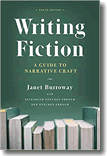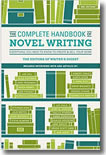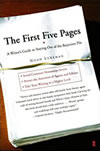
The WritingHundreds of well written books, essays, and articles, on-line and in-print detail the elements of writing, including, but not limited to: Story arc, story structure, plotting, three acts, opening lines, beginnings, middles, ends, showing versus telling, active versus passive voice, conflict and crisis, world building, emotion in words, outlining techniques and options, building characters and character development, protagonists and antagonists, exposition, narrative, dialogue, points of view, scenes and settings, pacing and balance, word usage, idioms and cliches, metaphors and similes, symbolism, grammar, punctuation, spelling, discipline of writing, plus individual instruction on each of the major genre: science fiction, horror, thriller and suspense, literary, mystery, fantasy, romance, erotica, historical, comedy, and others. If you seek just one book of understanding on writing well, a single tome of wisdom on the art and craft of narrative fiction, choose:  Writing Fiction, Tenth Edition: A Guide to Narrative Craft. Writing Fiction, Tenth Edition: A Guide to Narrative Craft.
From Amazon's description: Janet Burroway�s best-selling classic is the most widely used creative writing text in America, and for more than three decades it has helped hundreds of thousands of students learn the craft. Now in its tenth edition, Writing Fiction is more accessible than ever for writers of all levels�inside or outside the classroom. Burroway is the best single-source of must-know instruction for developing and maturing your talent. You will begin to think about dimensions of your manuscript in new ways before the end of the preface. When world-class writers write about writing, they develop a rhythm and flow that is as enjoyable to read as a good story. This text sets the bar very high.  A quality review of technique is curated by the editors of Writers Digest. Sixty-three essays provide best-selling advice examining writing from multiple angles:  The Complete Handbook of Novel Writing: Everything You Need to Know to Create & Sell Your Work
The Complete Handbook of Novel Writing: Everything You Need to Know to Create & Sell Your Work
 Part One: The Art and Craft of a Strong Narrative, 24 essays Part One: The Art and Craft of a Strong Narrative, 24 essays Part Two: The Writing Process, 11 essays Part Two: The Writing Process, 11 essays Part Three: Exploring Novel Genres, 12 essays Part Three: Exploring Novel Genres, 12 essays Part Four: Finding and Cultivating a Market for Your Work, 9 essays Part Four: Finding and Cultivating a Market for Your Work, 9 essays Part Five: Interviews with Novelists, 7 essays Part Five: Interviews with Novelists, 7 essays  Your opening must grab the attention of the reader and draw them in on the first page. This is the Hook.
Your opening must grab the attention of the reader and draw them in on the first page. This is the Hook.
To attract representation, this is the most critical part of your writing. To be sure, you can be rejected for lots of other reasons, but the prime directive is the first lines must be the best of your life. Noah Lukeman's The First Five Pages is an excellent resource. You'll find that the tools he suggests for the first pages will also elevate your writing throughout your manuscript. 
Something to ConsiderNot enough emphasis is given to the first two of the following writing techniques. I offer a blurb about each to draw attention to them as you hone the craft. The third is included to complete the Triple Crown of fine writing. Pacing provides control over how fast readers move through the story, or more skillfully, how fast it seems to the reader. Fast paced action scenes, moderate paced description of surroundings and character interactions, a few slower-paced periods of character self-reflection. Balance avoids reader fatique by varying the delivery of the story via dialog versus action versus narrative. Fine tuning a mixture of short and long sentences eschews monotony. And, of course, Showing versus Telling, the touchstone of successful writing, delivers images to the reader, allowing their imagination to fill in unrevealed visual dimensions of the story. At its finest, it puts the reader in the scene. It should be evident that good writing inextricably connects these.  There are many books that teach the disipline. See: Books for Writers, IQ140's favorites. Each has unique points and the serious writer should read them all... and others. |
|
© 2021, Robin D. Ader. All rights reserved. For more information, contact: Info%at%IQ140.com |



